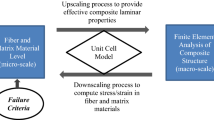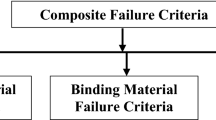The concept of a residual Daniels function (RDF) is introduced. Together with the concept of Daniels sequence, the RDF is used for estimating the residual (after some preliminary fatigue loading) static strength of a unidirectional fibrous composite (UFC) and its S–N curve on the bases of test data. Usually, the residual strength is analyzed on the basis of a known S–N curve. In our work, an inverse approach is used: the S–N curve is derived from an analysis of the residual strength. This approach gives a good qualitive description of the process of decreasing residual strength and explanes the existence of the fatigue limit. The estimates of parameters of the corresponding regression model can be interpreted as estimates of parameters of the local strength of components of the UFC. In order to approach the quantitative experimental estimates of the fatigue life, some ideas based on the mathematics of the semiMarkovian process are employed. Satisfactory results in processing experimental data on the fatigue life and residual strength of glass/epoxy laminates are obtained.


Similar content being viewed by others
References
V. Cimanis and Yu. Paramonov, “Fatigue curve approximation using Daniels’ sequence and Markov chains,” Material digest of the XXIV Sci. and Practical Conf. Theory and Practice in Physical, Mathematical and Technical Sciences, London: IASHE, 31-33 (2012).
Yu. Paramonov, V. Cimanis, and S. Varickii, “Aproximation of fatigue curve and fatigue limit of fibre composite using random Daniels’ sequence and Markov chains,” Aviation. 17, No. 3, 91-97 (2013).
Yu. Paramonov., V. Cimanis, S. Varickii, and M. Kleinhofs, “Investigation of the reliability and longevity of parallel systems with defects using Daniels’ sequences,” Automatic Control and Computer Sci., 47, No. 2, 87-93 (2013).
Yu. Paramonov., V. Cimanis, S. Varickii, and M. Kleinhofs, “Modeling the strength and fatigue life of a unidirectional fibrous composite using Daniels sequences and Markov chains,” Mech. of Compos. Mater., 49, No. 5, 821-838 (2013).
Yu. Paramonov., R. Chatys, J. Andersons, V. Cimanis, and M. Kleinhofs, “Markov models for tensile and fatigue reliability analysis of unidirectional fiber composite,” PT & A, 7, No. 3(26), 53-65 (2012).
Yu. Paramonov and M. Kleinhofs. Models of Reliability Analysis of Composite. - Lambert Saarbrucken, Germany, 2014.
Yu. Paramonov, A. Kuznetsov, and M. Kleinhofs,. “Reliabilty of fatigue-prone airframes and composite materials,” Riga: RTU, 2011. (<http://gnedenko-forum.org/library/Paramonov/Reliability_Paramonov.pdf>)
H. E. Daniels, “The statistical theory of the strength of bundles of threads,” Proc. Royal Soc. London, Ser. A., No. 183, 405-435 (1945).
H. E. Daniels, “The maximum of a Gaussian process whose mean path has a maximum, with an application to the strength of bundles of fibers,” Advances in Appl. Probability, 21, No. 2, 315-333 (1989).
T. P. Philippidis and V. A. Passipoularidis, “Residual strength after fatigue in composites: Theory vs.exsperiment,” Int. J. of Fatigue, 29, 2104-2116 (2007).
L. J. Broutman and S. Sahu “A new theory to predict cumulative fatigue damage in fibergfass reinforced plastics,” Composite Materials: Testing and Design. ASTM STP, 497, 170-188 (1972).
H. T. Hahn and R. Y. Kim, “Proof testing of composite materials,” J. Compos. Mater., 9, 297-311 (1975).
J. N. Yang and M. D. Liu, “Residual strength degradation model and theory of periodic proof test for grasphite/epoxy laminates,” J. Compos. Mater., 11, 176-203 (1977).
J. N. Yang and S. Du, “An exploratory study into the fatigue of composites under spectrum loading,” J. Compos. Mater., 17, 511-526 (1983).
T. Adam, R. F. Dickson, C. J. Jones, H. Reiter, and B. Harris, “A power law fatigue damage model for fiber-reinforced plastic laminates,” Proc. Inst. Mech. Engrs., No. 200 (C3), 155-166 (1986).
G. P. Sendeckyj, “Life prediction for resin-matrix composite materials,” Composite Material, Ser. 4., Elsevier, 1991, 431-483.
G. P. Sendeckyj, “Fitting models to composite materials fatigue data. Test methods and design allowables for fibrous composites,” ASTM. STP, 734., 245-260 (1981).
Yu. Paramonov., R. Chatys, J. Andersons, and M. Kleinhofs, “Markov model of fatigue of a composite material in the Poisson process of defect initiation,” Mech. Compos. Mater., 48, No. 2, 315-330 (2012).
Yu. Paramonov., R. Chatys, J. Andersons, V. Cimanis, and M. Kleinhofs, “Markov models for tensile and fatigue reliability analysis of unidirectional fiber composite,” PT & A, 7, No. 3(26), 53-65 (2012).
T. P. Philippidis, T. T. Assimakopoulou, V. A. Passipoularidis, and A. E. Antoniou, “Static and Fatigue Tests on ISO Standard ±45°, Coupons, Main Test Phase I, OB_TG2_R020_rev.00, August 2004. Available from: http://www.kcwmc.nl/optimatblades/Publications.
T. P. Philippidis, T. T. Assimakopoulou, A. E. Antoniou, and V. A. Passipoularidis, Residual Strength Tests on ISO Standard ±45°. Coupons, Main Test Phase I, OB_TG5_R008 _rev.000, July 2005. Available from: http://www.kc-wmc.nl/optimatblades/Publications.
T. P. Philippidis, T. T. Assimakopoulou, A. E. Antoniou, and V. A. Passipoularidis, Residual Strength Tests on ISO Standard ± 45 ° Coupons, Main Test Phase II, OB_TG2_R037.rev.000, June 2006. Available from: http:// www.kcwmc.nl/optimatblades/Publications <http://www.kc-wmc.nl/optimatblades/Publications>.
Author information
Authors and Affiliations
Corresponding author
Additional information
Translated from Mekhanika Kompozitnykh Materialov, Vol. 52, No. 4, pp. 703-716, July-August, 2016.
An erratum to this article is available at http://dx.doi.org/10.1007/s11029-016-9621-0.
Rights and permissions
About this article
Cite this article
Paramonov, Y., Cimanis, V., Varickis, S. et al. Modeling the Residual Strength of a Fibrous Composite Using the Residual Daniels Function. Mech Compos Mater 52, 497–506 (2016). https://doi.org/10.1007/s11029-016-9600-5
Received:
Published:
Issue Date:
DOI: https://doi.org/10.1007/s11029-016-9600-5




